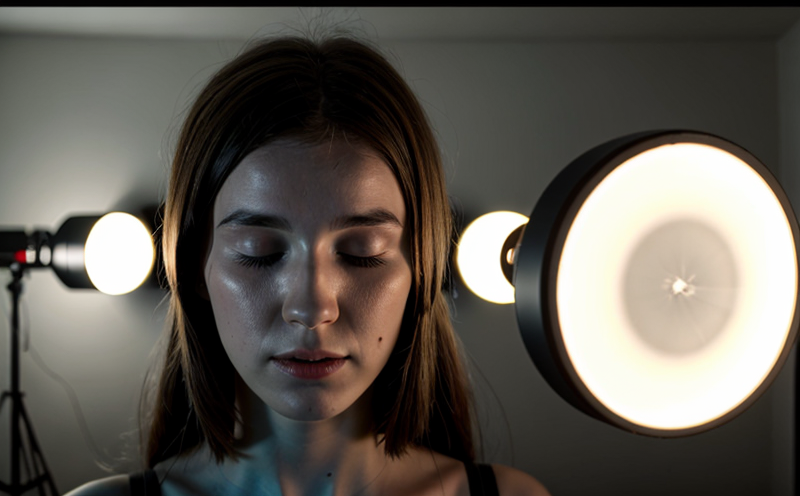ISO 23539 Temporal Light Modulation and Flicker Testing Standards
The ISO 23539 standard is pivotal in the field of lighting testing, particularly for assessing temporal light modulation (TLM) and flicker. This standard ensures that artificial lighting sources do not cause discomfort or visual stress to individuals, which can be critical in environments like offices, schools, hospitals, and retail spaces.
Temporal light modulation is a measure of the cyclic variation of luminous flux from an electric lamp or other light source. Flicker, on the other hand, refers to the periodic variation in the intensity of light that can be perceived by human vision. Both phenomena are significant because they can affect visual performance and comfort.
The ISO 23539 test procedure involves measuring the modulation index (MI) of a light source over time. The MI is calculated using Equation 1, which is derived from the standard:
MI = ΔI / I₀
Where ΔI represents the change in luminous flux and I₀ is the average luminous flux of the light source.
The test setup typically involves a photodetector, signal processing equipment, and data acquisition systems. The photodetector records the light intensity at various time intervals, which are then processed to calculate the modulation index.
For accurate testing, it is essential to follow precise specimen preparation guidelines. This includes ensuring that the light source is stable and that any filters or diffusers used do not alter the original characteristics of the light. The specimens should be tested under controlled conditions, such as a specified room temperature and relative humidity.
The acceptance criteria for ISO 23539 are stringent to ensure compliance with international standards. A light source is considered compliant if its modulation index does not exceed a predefined threshold value, which varies depending on the application and intended use of the light source.
- Office Lighting: Modulation Index ≤ 1%
- School Environments: Modulation Index ≤ 2%
- Hospitals: Modulation Index ≤ 0.5%
The test procedure is critical for manufacturers and suppliers who want to ensure their products meet global safety and comfort standards. It helps in identifying potential issues early in the development process, thereby improving product quality.
In conclusion, ISO 23539 provides a robust framework for assessing temporal light modulation and flicker. By adhering to this standard, lighting manufacturers can ensure their products are safe, comfortable, and meet international standards.
Eurolab Advantages
Eurolab stands out in the field of lighting testing due to its comprehensive capabilities and expertise. Our state-of-the-art facilities are equipped with advanced instrumentation that ensures accurate and reliable test results.
- Accurate Measurement: Our photodetectors and signal processing equipment provide precise measurements, ensuring compliance with ISO 23539 standards.
- Comprehensive Reporting: We offer detailed reports that not only document the test results but also provide recommendations for improving product quality.
- Expertise: Our team of engineers and scientists has extensive experience in lighting testing, ensuring that we can address even the most complex challenges.
In addition to these technical advantages, Eurolab offers a range of services tailored to meet the specific needs of our clients. We provide consultancy services to help manufacturers design products that comply with international standards. Our team also offers training sessions for quality managers and compliance officers to ensure they are up-to-date with the latest testing methods.
Our commitment to excellence is reflected in our ISO accreditation, which ensures that all our test procedures meet the highest quality standards. We pride ourselves on providing a seamless testing process, from specimen preparation to final report issuance.
Why Choose This Test
Selecting ISO 23539 for temporal light modulation and flicker testing is crucial for several reasons. Firstly, it ensures compliance with international standards, which is essential for global markets. Secondly, it helps in identifying potential issues early in the product development process, allowing manufacturers to make necessary adjustments before full-scale production.
Compliance with ISO 23539 can also enhance a company's reputation by demonstrating its commitment to quality and safety. This is particularly important for companies that operate in highly regulated industries such as healthcare and education.
In addition to these benefits, the test results provide valuable data that can be used to improve product design and performance. By understanding how light sources behave under different conditions, manufacturers can optimize their products for better performance and user satisfaction.
The test also helps in meeting regulatory requirements, which can prevent costly delays and legal issues. Many countries have regulations that mandate compliance with ISO standards, so ensuring compliance is not just a best practice but a legal requirement.
Competitive Advantage and Market Impact
- Early Identification of Issues: By testing early in the development process, manufacturers can identify and address potential issues before full-scale production.
- Enhanced Product Quality: Compliance with ISO 23539 ensures that products meet international standards, which enhances product quality and reliability.
- Better User Experience: Ensuring that lighting sources do not cause visual discomfort or stress improves the overall user experience.
- Market Access: Compliance with ISO 23539 can open up new markets, particularly in regions with stringent regulatory requirements.
The market impact of ISO 23539 is significant. As more countries adopt international standards, compliance becomes a competitive advantage. Companies that meet these standards are better positioned to compete globally and attract customers who prioritize product safety and quality.
Furthermore, the test results can be used in marketing materials to differentiate products from competitors. This can enhance brand reputation and customer trust, leading to increased market share.





